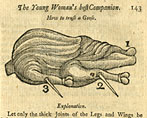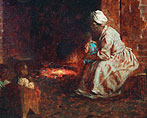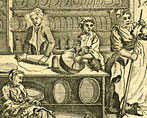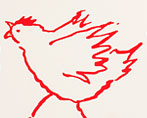Education
Fire and Freedom: Food and Enslavement in Early America presents the following classroom resources for K-12 and undergraduate educators and their students. These resources serve as templates for examining foodways with the historical context of European settlement and slavery during early America. Educators are welcome to adapt them in whole or in part as appropriate for their students’ interests and academic goals.
Lesson Plans
A Fine Dessert
- Grade level: 3–5
- Subject: health education
The lesson uses an apple pie recipe from a primary source—a 1773 publication—included in the online exhibition Fire and Freedom. From the recipe of a well-known dessert, students are guided to consider how a dessert fits into a healthy, balanced meal. Students learn about the visual representations of the five food groups and relative portions illustrated by the USDA’s MyPlate diagram.
What Stories Do Meals Tell
- Grade level: 9–12
- subject: history and social studies
In this lesson, students examine primary source materials to learn about a two-course, mid-day meal viewing a ‘winter dinner’ diagram and related recipes from a 1773 publication. Class activities and guided discussions focus on placing the meal in America in 1700s during the time of slavery. The narratives of the Fire and Freedom online exhibition guide students’ exploration of the idea that meals tell stories of not only places and season, but also of peoples and power dynamics among them.
Higher Education
“All the Slaves Ate Together”: African American Foodways and the Colonial Era
“All the Slaves Ate Together”: African American Foodways and the Colonial Era is a module developed for undergraduate and graduate level courses to accompany the National Library of Medicine exhibition, Fire and Freedom: Food, Enslavement in Early America. Psyche Williams-Forson, PhD, authored this module that uses African American food history and the history of the early Chesapeake region to promote understanding of the complex dynamics that surround food cultures. The module explores the difficulties and challenges of being enslaved through the lenses of food preparation and consumption.
Online Activities
The Art of Trussing or Trussing Game
Learn how to truss game for cooking in an open fire.
Dinner in 1773
Discover several dishes and their recipes from this elegant, two-course winter dinner by Eliza Smith.
Looking into 18th-Century Kitchens
Look into these two kitchen illustrations and explore several tools and various tasks in preparing a meal.
Other Resources
Continue to learn about food and enslavement, African American foodways, and food during colonial America with these lists of sample resources for additional readings: Curator’s Bibliography, K-12 Suggested Readings, and Online Resources.
Continue to OTHER RESOURCES






